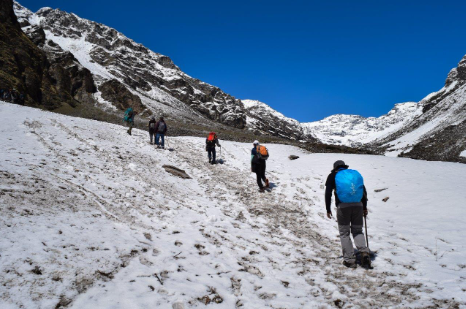Introduction
Nestled in the lap of the Indian Himalayas, the Rupin Pass trek is a breathtaking journey that offers trekkers an opportunity to traverse through some of the most stunning landscapes in the world. This challenging trek takes you from the quaint village of Dhaula in Uttarakhand to Sangla in Himachal Pradesh, covering a distance of approximately 52 kilometers over eight days. Tracing the Rupin Pass is a trekker’s odyssey that unveils not only the natural beauty of the region but also the diverse cultures and traditions that thrive in this remote corner of India.
Dhaula – The Journey Begins
The adventure commences in the small village of Dhaula, a gateway to the Rupin Pass trek. The trail begins on a relatively gentle note, with trekkers making their way through dense forests, crossing rustic bridges over gushing streams. This day is often considered a warm-up for the challenging terrain that lies ahead. The sound of the Rupin River accompanies trekkers throughout the journey.
Dhaula’s Enigmatic Landscape:
As trekkers set foot in Dhaula, they are immediately struck by the natural beauty of the region. The village is surrounded by lush, terraced fields, with the Rupin River gurgling in the background. The gentle murmurs of the river, combined with the chirping of birds, create a serene atmosphere that offers a stark contrast to the bustling urban life most trekkers are accustomed to.
A Step Back in Time:
Dhaula appears to be frozen in time, with traditional wooden houses that exude an air of simplicity and authenticity. The locals, primarily engaged in agriculture and animal husbandry, still maintain their age-old customs and traditions. The opportunity to observe and interact with them provides trekkers with a unique window into the indigenous culture of the Himalayan foothills.
Sewa – The Remote Hamlet
On the second day, trekkers reach the secluded village of Sewa, home to a welcoming community. The villagers here have a unique way of life, with their distinctive customs and traditions. Trekkers get a glimpse into the rustic beauty and simplicity of mountain life as they explore Sewa and interact with the locals.
Overnight Stay in Sewa:
Trekkers usually spend the night in Sewa, camping or staying with local families. The experience of sleeping in the village, surrounded by the sounds of nature and the quiet rhythm of life in the mountains, is a memorable part of the journey. It also offers a chance to reflect on the day’s experiences and bond with fellow trekkers.
Scenic Trail to Sewa:
The trek from Dhaula to Sewa offers trekkers stunning vistas of the surrounding landscape. The path meanders through thick forests, along rustic bridges spanning gushing streams, and past terraced fields that are a testament to the agricultural practices of the region. The scenery, with the Rupin River accompanying trekkers throughout, becomes increasingly dramatic as they make their way to Sewa.
Jhaka – A Glimpse into Kinnauri Culture
The trek progresses to Jhaka, a picturesque Kinnauri village. Trekkers are greeted by wooden houses adorned with intricate carvings and vibrant prayer flags fluttering in the breeze. The Kinnauri people have a rich culture, and their customs and attire reflect the unique blend of Indian and Tibetan influences.
Saruwas Thatch – The Alpine Meadow
The trail ascends to the serene Saruwas Thatch, an enchanting alpine meadow surrounded by towering peaks. Here, trekkers camp under the celestial Himalayan night and enjoy a surreal experience of being amongst nature’s raw beauty.
Dhanderas Thatch – A Change in Scenery
The landscape converts as trekkers make their way to Dhanderas Thatch, a campsite with a striking contrast of red cliffs and emerald-green meadows. This is a challenging part of the trekking, where trekkers need to navigate rocky paths and steep inclines.
Upper Waterfall Camp – Rupin Waterfall
One of the highlights of the Rupin Pass trekking is the awe-inspiring Rupin Waterfall. Trekkers ascend steep terrain to witness this natural wonder – a cascade of glacial meltwater that thunders down from the heights. The view of the waterfall is a sight to behold and a well-deserved reward for the trekking’s difficulties.
Rupin Pass – The Ultimate Achievement
The climax of the trekking arrives on the seventh day as trekkers conquer Rupin Pass. The pass stands at an elevation of approximately 15,250 feet and provides panoramic views of snow-clad peaks. Trekkers celebrate their achievement while taking in the breathtaking vistas that surround them.
Sangla – Journey’s End
The descent from the pass leads trekkers to the beautiful town of Sangla in Himachal Pradesh. Here, the trekking concludes, leaving trekkers with a sense of achievement and a trove of memories that will last a lifetime.
Conclusion
Tracing the Rupin Pass is not just a physical journey; it’s a trekker’s odyssey that takes you through a delightful blend of landscapes, cultures, and traditions. From the peaceful villages of Sewa and Jhaka to the breathtaking Rupin Waterfall and the grandeur of Rupin Pass, this trekking is a test of endurance and a celebration of nature’s greatness. It is an odyssey that beckons adventurers to experience the raw, untouched beauty of the Indian Himalayas and provides a glimpse into the lives of those who call this area their home.

















